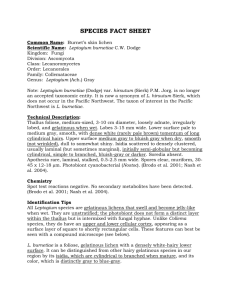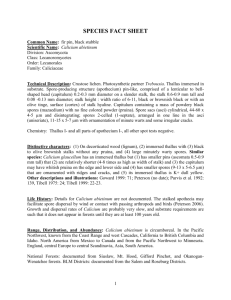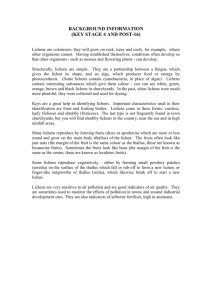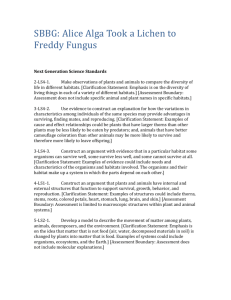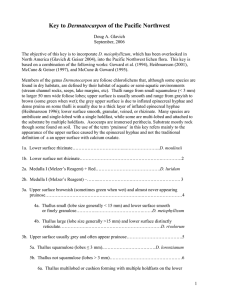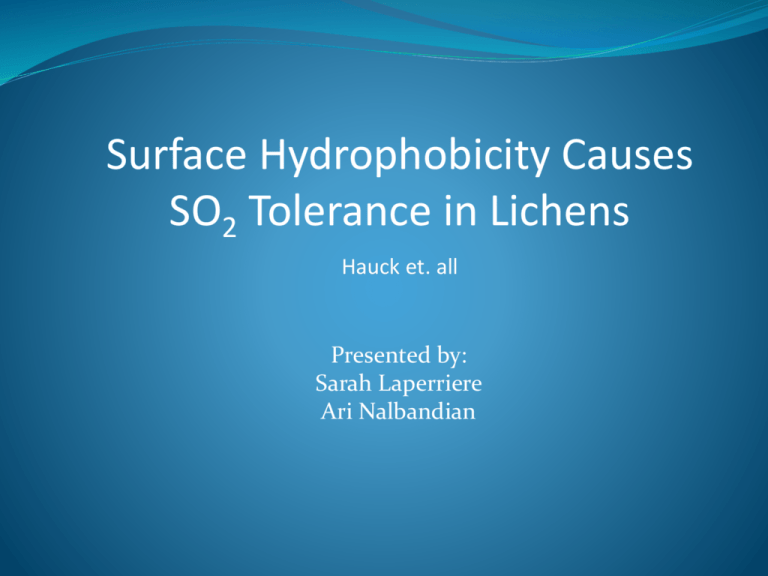
Surface Hydrophobicity Causes
SO2 Tolerance in Lichens
Hauck et. all
Presented by:
Sarah Laperriere
Ari Nalbandian
Purpose
Does surface
hydrophobicity cause
sulfur dioxide resistance?
Key Words
Hydrophobic (water-fearing)
Repels water
Hydrophilic (water-loving)
Attracted to water
Contact Angle
Markus Hauck
Georg-August University of Göttingen
Interests include:
Lichen secondary metabolites
Biodiversity
Global change ecology
Long walks on the beach
http://www.goettingen.studip.de/extern.php?module=Persondetails&config_id=91362d34fe8a
e37349a29787e7d&range_id=2b648cb9a0cf4573c5d4c3d661e6d1df&username=mhauck
Sulfur Dioxide (SO2)
http://volcanoes.usgs.gov/Imgs/Jpg/GasEffects/GasesChemistry.jpg
Why Be Hydrophobic?
Thallus saturated with water = less gas exchange = less
photosynthesis
Hydrophobic thallus exterior prevents thallus from
becoming saturated
http://www.buffelskloof.info/images/Lichen%20detail.JPG
Variables
Independent - Lichen SO2 tolerance
Dependent - Lichen hydrophobicity
Experimental Design
50 lichen species, known low to high SO2 sensitivities
500 m deionized water droplets placed on surface of
air-dry thalli
Contact angles measured to quantify hydrophobicity
Replicated 5 times
Lichens extracted with acetone to remove extracellular
substances
Methods of Tabulation and
Evaluation
Contact Angle
http://www.dsm.com/en_US/html/dep/adhesive_bonding.htm
Results
Table 2: contact angles of water droplet placed on
the thallus surface of lichen species
http://aob.oxfordjournals.org/content/101/4/531/T2.ex
pansion.html
Water droplets placed on the surface of lichen thalli of Bacidina inundata (A), Cetraria
islandica (B), Cladonia coniocraea, podetium (C), C.
Hauck M et al. Ann Bot 2008;101:531-539
© The Author 2007. Published by Oxford University Press on behalf of the Annals of Botany
Company. All rights reserved. For Permissions, please email:
journals.permissions@oxfordjournals.org
Data Interpretation
“Increasing SO2 tolerance with increasing
hydrophobicity of the thallus surface in a set of 50
lichen species suggests that SO2 tolerance in lichens
primarily depends on the ability to reduce uptake of
acidic precipitation containing SO2 and its derivatives
formed in aqueous solution.”
Contact angles of water droplets placed on the surface of lichens of different SO2 tolerance
(A) or growth form (B).
Hauck M et al. Ann Bot 2008;101:531-539
© The Author 2007. Published by Oxford University Press on behalf of the Annals of Botany
Company. All rights reserved. For Permissions, please email:
journals.permissions@oxfordjournals.org
Strengths & Weaknesses
Strengths
Data significance, clarity
Discusses buffering capacity of substratum
Discusses characteristics of hydrophilic lichen
Weaknesses
Do not discuss role of systematic position, thallus
morphology, or photobiont choice
Do not discuss hydrophobic substances on thallus
Sensitivities of some species still lacking



